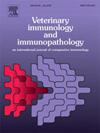简短交流:年龄对犊牛接种流产布鲁氏菌S19或RB51免疫反应的影响
IF 1.4
3区 农林科学
Q4 IMMUNOLOGY
引用次数: 0
摘要
牛小牛疫苗接种是牛布鲁氏菌病流行地区控制牛布鲁氏菌病的主要政策之一。然而,动物年龄对疫苗免疫原性的影响尚不清楚,这可能有助于确定理想的接种年龄,以最大限度地提高免疫反应。因此,本研究的目的是比较不同年龄(3 ~ 8月龄)犊牛接种abortus B. S19和RB51菌株后,经刺激的PBMC体外表达IFN-γ的情况。通过培养外周血单个核细胞(PBMC)和酶联免疫吸附法(ELISA)定量上清中IFN-γ来评估细胞介导的免疫应答。此外,采用2-巯基乙醇(2-ME)、标准试管凝集(STAT)和荧光偏振试验(FPA)进行血清学检测。在接种当日、接种后28天和56天采集血样和血清。采用广义线性混合模型来评估接种年龄对体外产生IFN-γ的影响,RB51和S19疫苗在不同年龄之间没有差异(p >; 0.05)。与5 - 6个月[50 %(5/10)]和7-8个月[27.28 %(3/11)]相比,3-4月龄接种S19的动物在第56天恢复血清学阴性的比例更高[77.28 %(7/9)]。总之,我们的研究结果表明,接种S19和RB51菌株后,3至8月龄的动物体外产生的IFN-γ水平相似。本文章由计算机程序翻译,如有差异,请以英文原文为准。
Short communication: Effects of age on the immune response induced by Brucella abortus S19 or RB51 vaccination in calves
Vaccination of bovine calves is one of the main policies for bovine brucellosis control in endemic areas. However, the effect of animal age on vaccine immunogenicity is still unknown and could help to determine an ideal age for vaccination, in order to maximize immune response. Thus, the objective of this study was to compare the in vitro expression of IFN-γ by stimulated PBMC after vaccination with B. abortus S19 and RB51 strains in calves vaccinated at different ages, between 3 and 8 months. Cell-mediated immune response was assessed through culture of peripheral blood mononuclear cells (PBMC) and quantification of IFN-γ in the supernatant by enzyme-linked immunosorbent assay (ELISA). In addition, serological assays were performed using 2-mercaptoethanol (2-ME), Standard Tube Agglutination (STAT) and Fluorescent polarization assay (FPA) tests. Blood samples and sera were collected in the inoculation day, as well as at 28 and 56 days after vaccination. A generalized linear mixed model was used to evaluate effect of age at vaccination on in vitro production of IFN-γ and no differences were observed comparing the different ages, for both RB51 and S19 vaccines (p > 0.05). A higher percentage of animals vaccinated with S19 at 3–4 months-old [77.28 % (7/9)] returned to the serological negative status at day 56, when compared to 5–6-months [50 % (5/10)] and 7–8 months-old animals [27.28 % (3/11)]. In conclusion, our findings indicated similar levels of IFN-γ in vitro production in animals between 3 and 8 months of age, following vaccination with S19 and RB51 strains.
求助全文
通过发布文献求助,成功后即可免费获取论文全文。
去求助
来源期刊
CiteScore
3.40
自引率
5.60%
发文量
79
审稿时长
70 days
期刊介绍:
The journal reports basic, comparative and clinical immunology as they pertain to the animal species designated here: livestock, poultry, and fish species that are major food animals and companion animals such as cats, dogs, horses and camels, and wildlife species that act as reservoirs for food, companion or human infectious diseases, or as models for human disease.
Rodent models of infectious diseases that are of importance in the animal species indicated above,when the disease requires a level of containment that is not readily available for larger animal experimentation (ABSL3), will be considered. Papers on rabbits, lizards, guinea pigs, badgers, armadillos, elephants, antelope, and buffalo will be reviewed if the research advances our fundamental understanding of immunology, or if they act as a reservoir of infectious disease for the primary animal species designated above, or for humans. Manuscripts employing other species will be reviewed if justified as fitting into the categories above.
The following topics are appropriate: biology of cells and mechanisms of the immune system, immunochemistry, immunodeficiencies, immunodiagnosis, immunogenetics, immunopathology, immunology of infectious disease and tumors, immunoprophylaxis including vaccine development and delivery, immunological aspects of pregnancy including passive immunity, autoimmuity, neuroimmunology, and transplanatation immunology. Manuscripts that describe new genes and development of tools such as monoclonal antibodies are also of interest when part of a larger biological study. Studies employing extracts or constituents (plant extracts, feed additives or microbiome) must be sufficiently defined to be reproduced in other laboratories and also provide evidence for possible mechanisms and not simply show an effect on the immune system.

 求助内容:
求助内容: 应助结果提醒方式:
应助结果提醒方式:


